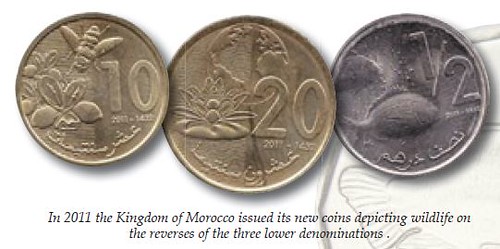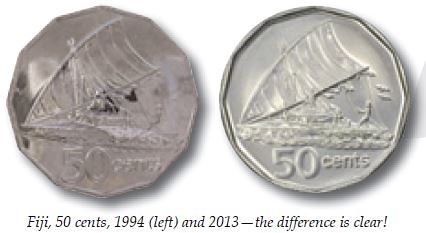
Philip McLoughlin published a thoughtful article in the December 2014 issue of Coin News. Here are some excerpts.
Titled "Numismatic Trends of the 21st Century", the article explores several long-term changes in circulating coinage. -Editor
NOW that we are at the end of 2014, the numismatic trends of the 21st century are becoming easier to discern. Some of them originated in the last
part of the 20th century but have since become more widespread and visible. In every case, there are also examples that go against the trend, but by
defi nition they are fewer than those following the trend. I shall confine myself here to those trends that affect circulation coins: trends
involving coloured coins and other marketing gimmicks do not interest me.
The disappearing humans
The first trend I have noticed is that there are fewer humans on coins: not generic humans, such as those depicted riding a horse or driving a
tractor, but known personalities. A good example is Latin America, where, back in the late 20th century, the circulation coins of almost every
country used to include portraits of their national heroes and liberators of the 1800s—generally high-collared military men with side whiskers.
The USA, by contrast, has long had a tradition of honouring its former presidents—though never a current president—on its coinage. That is
unlikely to change soon, so the trend against human portraits on standard circulation coins will probably never be universal. However, human
personalities, of past and present, will always be in demand on commemorative circulation coins.
Allegorical figures on the way out?
The second trend I discern is that allegorical fi gures are less common on coins. They were to be found on the coins of Italy and Portugal, before
those countries adopted the euro, but no longer. Marianne still lives on, and can be seen on the coins of French Polynesia and New Caledonia also.
Since 2008 even old Britannia has disappeared from the new coins of the UK— though the older ones continue to circulate, and she still graces the
gold Britannia coins named after her.
The continuing rise of the thematic set
 The third visible trend is that modern thematic sets, depicting wildlife, ships and architecture, are becoming more common. I have mentioned the
recent wildlife series of Colombia and Uruguay, but Morocco is another recent example. Formerly such countries were more likely to employ rather
old-fashioned designs incorporating heraldry, wreaths, symbolic devices or elaborate patterns. The United Arab Emirates, which introduced a thematic
set in the 1970s, was an early exception among Arab states, but Algeria was the next to issue a thematic set (of beautiful wildlife designs) in the
1990s. Many sub-Saharan African countries have long produced design series depicting wildlife, but until recently the deeply conservative North
African and Middle Eastern countries have generally avoided such themes.
The third visible trend is that modern thematic sets, depicting wildlife, ships and architecture, are becoming more common. I have mentioned the
recent wildlife series of Colombia and Uruguay, but Morocco is another recent example. Formerly such countries were more likely to employ rather
old-fashioned designs incorporating heraldry, wreaths, symbolic devices or elaborate patterns. The United Arab Emirates, which introduced a thematic
set in the 1970s, was an early exception among Arab states, but Algeria was the next to issue a thematic set (of beautiful wildlife designs) in the
1990s. Many sub-Saharan African countries have long produced design series depicting wildlife, but until recently the deeply conservative North
African and Middle Eastern countries have generally avoided such themes.
Downsizing?
The fourth, very noticeable, trend, is that coins are getting smaller, thinner and lighter. Artists complain that the resultant lower relief makes it
technically more diffi cult to produce a satisfying design. This all comes down to cost. As metals rise in price, so mints want to use them in
smaller quantities, or else they use cheaper metals, which are then plated in order to produce coins of the desired colour. Some countries resist
this trend, notably mineral-rich Australia, whose huge 50 cents coin—31.5mm in diameter and weighing over 15 grams—buys you very little these
days.
The inner polygonal rim
 The fifth trend is arguably related to the fourth. Polygonal coins, such as the heptagonal 50p and 20p in the UK, are still popular in some
countries, but in countries such as Fiji, the East Caribbean States, the Solomon Islands and Swaziland, they have been replaced by coins with an
inner polygonal rim. Such coins seem polygonal at fi rst glance, but on closer inspection it is apparent that they are round. Is this trend a product
of fashion or function? It is hard to tell. Some say that as coins become smaller and lighter, it becomes correspondingly harder for vending machines
to recognise polygonal coins. I am not so sure about this, since technology generally improves signifi cantly over time. Perhaps an inner polygonal
rim is harder to forge successfully, but I have no evidence for this.
The fifth trend is arguably related to the fourth. Polygonal coins, such as the heptagonal 50p and 20p in the UK, are still popular in some
countries, but in countries such as Fiji, the East Caribbean States, the Solomon Islands and Swaziland, they have been replaced by coins with an
inner polygonal rim. Such coins seem polygonal at fi rst glance, but on closer inspection it is apparent that they are round. Is this trend a product
of fashion or function? It is hard to tell. Some say that as coins become smaller and lighter, it becomes correspondingly harder for vending machines
to recognise polygonal coins. I am not so sure about this, since technology generally improves signifi cantly over time. Perhaps an inner polygonal
rim is harder to forge successfully, but I have no evidence for this.
Bimetallics rule, OK?
The sixth trend is the continuing rise of the bimetallic coin. It has a long history, but as a circulation coin it was commonly seen only from the
end of the 1980s onwards. The French adopted it for their 10 francs coin in 1988, and even post-Soviet Russia briefly introduced circulating
bimetallic 50 rouble and 100 rouble coins from 1992.
Hi-tech developments
The seventh trend is the increasing use of latent images and laser marks, as seen on this Canadian 2 dollar coin of 2012. Like bimetal, these
features help protect coins against forgery. Recently the UK Treasury and Royal Mint went further down that route, by announcing a new secure
bimetallic pound coin for 2017. The new coin is a product of iSIS, “Integrated Secure Identification Systems”, which incorporates three tiers of
banknote-strength security and can be authenticated via highspeed automated detection. The Mint claims that it possesses overt, covert and forensic
security features. In the near future perhaps every country’s high denominations will include such features. In this hi-tech age, it should be
possible to place forgery beyond the capabilities of the amateurs.
Goodbye to coins?
The eighth trend is the decreasing use of coins. If I travel by public transport here in London, I never use cash: I simply swipe my personal travel
card (the Oyster card). When the balance on my card falls below a certain amount, it is automatically topped up from my bank account. At
supermarkets, however, rather than proffering a credit or debit card, I prefer to use cash at the self-service checkout where, unlike a human, the
uncomplaining machine happily relieves me of my piles of unwanted pennies.
It is possible that in 20 years’ time coins will no longer be needed—at least in the technologically advanced countries. I have read that stamp
collecting is in decline because fewer people use stamps in the age of the email. How long before technology sends coins along the same path?
For more information or to subscribe to Coin News, see:
http://www.tokenpublishing.com/coins.asp
ROSENBLUM AUCTION ACTION

Our Fall 2014 auction is our best in over 44 years of issuing auction catalogs and price-lists. One of the finest collections of Israel and Palestine
coins and paper along with other fine consignments. Please click on the link to the auction here .
Or call or email us. A limited number of printed paper catalogs are also available which we will make available to any E-Sylum reader gratis
as long as our supply lasts.
Bill Rosenblum Bill@Rosenblumcoins.com 720-981-0785
Wayne Homren, Editor
The Numismatic Bibliomania Society is a non-profit organization
promoting numismatic literature. See our web site at coinbooks.org.
To submit items for publication in The E-Sylum, write to the Editor
at this address: whomren@gmail.com
To subscribe go to: https://my.binhost.com/lists/listinfo/esylum
Copyright © 1998 - 2024 The Numismatic Bibliomania Society (NBS)
All Rights Reserved.
NBS Home Page
Contact the NBS webmaster
|




